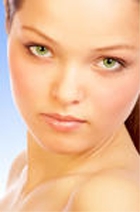Skin aging solutions
In zootomy and dermatology, skin is an organ of the integumentary system composed of a layer of tissues that protect underlying muscles and organs. As the interface with the surroundings, it plays the most important role in protecting against pathogens. Its other main functions are insulation and temperature regulation, sensation and vitamin D and B synthesis. The dermis can be split into the papillary and reticular layers. The papillary layer is outermost and extends into the dermis to supply it with vessels. It is composed of loosely arranged fibres. Papillary ridges make up the lines of the hands. The reticular layer is more dense and is continuous with the hypodermis. It contains the bulk of the structures (such as sweat glands). The reticular layer is composed of irregularly arranged fibres and resists stretching. Skin can be dividided into thick and thin types. Thick skin is present on the soles of the feet and the palms of the hands. It has a larger stratum corneum with a higher keratin content. Thick skin does not grow hair; its purpose is to help grip. Thin skin is present on the bulk of the body and has a smaller stratum corneum and fewer papillae ridges. It has hair and is softer and more elastic. The characteristics of the skin, including sensory nerve density and the type of hair, vary with location on the body. The skin must be regularly cleaned. Unless enough care is taken it will become cracked or inflamed. Unclean skin favors the development of pathogenic organisms. |
Learn obesity
Obese people should be evaluated for medical consequences of their obesity. Motivated persons are encourage to enter medically supervised treatment programs that use a multidisciplinary approach to weight loss. Many people are tempted by ads that use celebrities to tout liquid fasting diets for weight loss. Ads claim quick and easy weight loss with use of such products. Very obese patients may be referred to these types of diets. Their diets are carefully supervised by their healthcare provider. Fasting diets for weight loss may be right for obese persons who have serious weight-related medical problems. Rapid weight loss is the primary advantage of using these diets. This may be helpful in motivating the individual to continue with the program. This may help to support lifestyle changes which are needed for continued weight loss. Medically supervised fasts are very low calorie diets which provide from 400 to 800 calories per day. While most of these diets are low in calories, the protein provision is very high. The purpose of these diets is to promote fat loss, not muscle loss. The high protein content helps prevent large losses of muscle tissue. Electrolytes, vitamins and minerals are also supplemented. Binge eating can be difficult to control because many people turn to food as a way of dealing with their feelings. Keeping a food diary can be beneficial in identifying specifically what feelings are likely to trigger binge eating as well as what types of foods are consumed during a binge. Strategies can then be employed to reduce the urge to binge when the impulse strikes. |
Understanding anxiety
Both fear and anxiety send signals through the body that prepare all systems for possible danger. Hormones, such as adrenaline and catecholamine, are released in what is known as the "fight or flight" response. The sudden increase in hormone levels speeds up the heart and increases the amount of blood being pumped. At the same time, the muscles tighten, increasing the individual's ability to fight or flee from danger. The intensity of these physiological responses varies according to the seriousness of the event or thought that sparked the emotion, the strength of the individual's fear or anxiety, and his or her previous experience and genetic makeup. Thousands of scientific studies over the past several years show that high blood pressure, ulcers, migraine headaches, strokes, alcoholism, depression, anger, fatigue, drug addiction and many other medical conditions are often due to the long-term effects of stress. Diet also can be a culprit. The most common dietary offenders are caffeine and caffeine-like substances found in coffee, tea, and many soft drinks. In sensitive individuals, the jitteriness precipitated by caffeine can reach panic levels. In rare cases, extreme vitamin deficiencies may also lead to anxiety. Many organizations today supports research into the causes, diagnosis, prevention, and treatment of anxiety disorders and other mental illnesses. Studies examine the genetic and environmental risks for major anxiety disorders, their course--both alone and when they occur along with other diseases such as depression--and their treatment. The ultimate goal is to be able to cure, and perhaps even to prevent, anxiety disorders. Like heart disease and diabetes, the brain disorders are complex and probably result from a combination of genetic, behavioral, developmental, and other factors. You may be concerned about paying for treatment for an anxiety disorder. If you belong to a Health Maintenance Organization or have some other kind of health insurance, the costs of your treatment may be fully or partially covered. There are also public mental health centers that charge people according to how much they are able to pay. If you are on public assistance, you may be able to get care through your state Medicaid plan. |
|
|
Read our other articles:
Natural herbal diet pills Hoodia that attacks fat
What is it erectile dysfunction?
Return back your hair with hair transplantation
Teeth treatment and modern dentistry
How to evaluate health information
Women's discomfort from premenstrual syndrome and diets